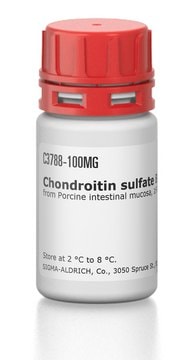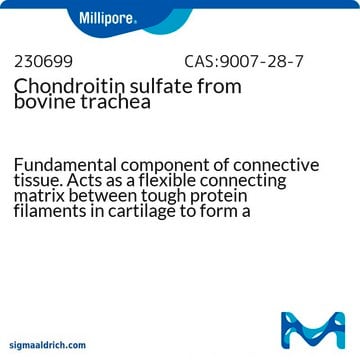C6737
Chondroitin sulfate sodium salt from bovine cartilage
98-102% (CPC, titration)
About This Item
Recommended Products
biological source
bovine cartilage
grade
standard (for CPC (cetylpyridinium chloride) titration)
Assay
98-102% (CPC, titration)
form
powder
optical activity
[α]20/D -30 to -20 °, c = 5% (w/v) in water
impurities
<10.0% water (Karl Fischer)
color
white to off-white
solubility
H2O: soluble 50 mg/mL, clear to hazy, colorless to faintly yellow
cation traces
Na: 7.4-8.8% (anhydrous)
storage temp.
2-8°C
SMILES string
[Na+].CC(=O)N[C@H]1[C@H](O)O[C@H](CO)[C@H](OS([O-])(=O)=O)[C@@H]1O[C@H]2O[C@@H]([C@H](O)[C@@H](O)[C@@H]2O)C(O)=O
General description
Application
Biochem/physiol Actions
Components
Caution
Preparation Note
Other Notes
Storage Class Code
13 - Non Combustible Solids
WGK
WGK 2
Flash Point(F)
Not applicable
Flash Point(C)
Not applicable
Personal Protective Equipment
Certificates of Analysis (COA)
Search for Certificates of Analysis (COA) by entering the products Lot/Batch Number. Lot and Batch Numbers can be found on a product’s label following the words ‘Lot’ or ‘Batch’.
Already Own This Product?
Find documentation for the products that you have recently purchased in the Document Library.
Customers Also Viewed
Our team of scientists has experience in all areas of research including Life Science, Material Science, Chemical Synthesis, Chromatography, Analytical and many others.
Contact Technical Service







